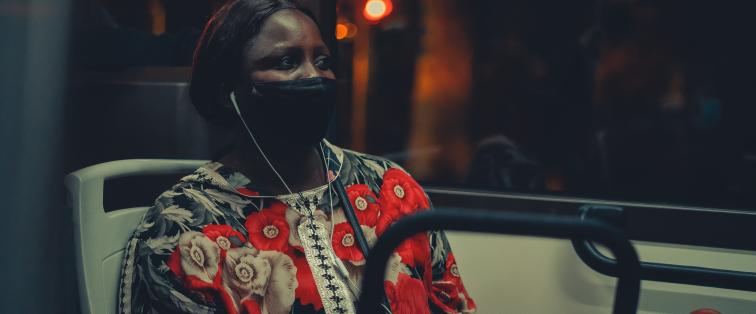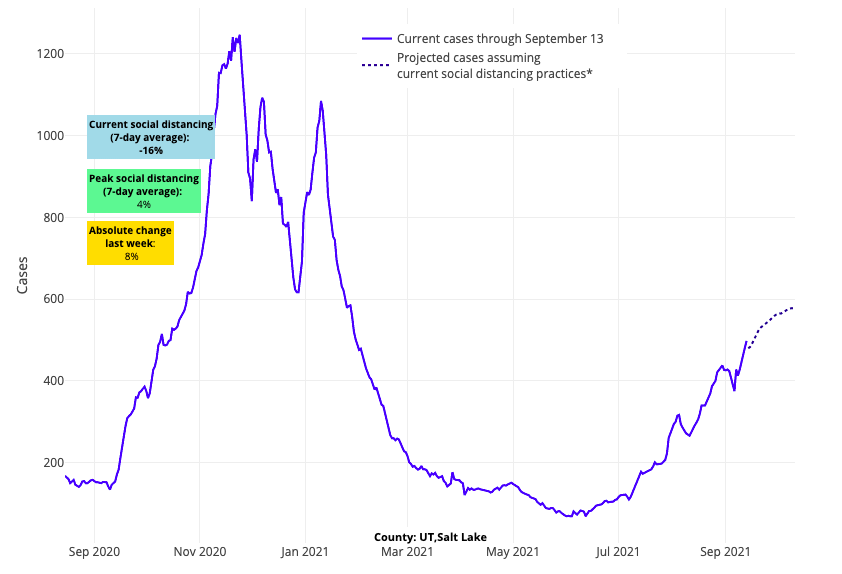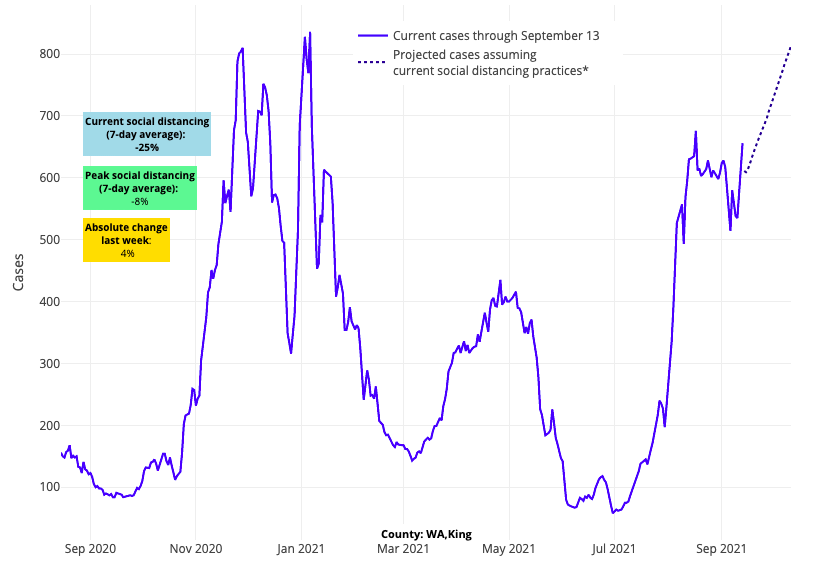COVID-19 Outlook: Post-Labor Day Impacts Emerge as the South Improves

With COVID-19 cases continuing to increase in many parts of the country and an ever-evolving situation with children back in-person at schools, the COVID-Lab modeling team has decided to reinstate our weekly county-level projections for the 821 counties we have been monitoring. While the national numbers suggest a plateauing of the current surge, it is becoming ever more important to assess the data at a local level. Here are some big takeaways from this week’s data:
National Assessment:
- The national average PCR testing positivity rate is 12.5%, relatively unchanged in the last two weeks. Average case incidence across the U.S. fell slightly to 368 weekly cases per 100,000 residents.
- The national average reproduction number (a measure of transmission that estimates how many additional individuals, on average, will be infected by every positive case) dropped just below 1 (0.98) last week, a number consistent with the plateauing of the national PCR positivity rate and case incidence.
- National adult hospital census dropped back down close to 90,000 individuals this week, as pediatric census remained flat at just above 1,500 children.
Regional and County-level Assessment:
- More than two-thirds of the 821 counties we monitor had an average PCR testing positivity rate over 9%, one-third were still exceeding 400 weekly cases per 100,000 residents, and one-quarter had a higher reproduction number this week compared to the prior week. States home to numerous counties with high reproduction numbers include Colorado, Idaho, Georgia, Ohio and Tennessee.
- Our models project steep declines in case incidence in some parts of the Southeast and across lower Texas in the coming weeks, while other areas throughout Georgia, Kentucky, Tennessee and West Virginia have not yet reached their peaks.
- Case incidence in the Upper Midwest and other areas of the Northeast, is persistently high but flat. Our models forecast moderate growth in case incidence across Maine, Massachusetts and New Hampshire over the next four weeks. With colder weather on the way and slightly worse projections in northern New England, the risk for continued growth in this region bears watching.

Above are the projections for Essex County in Massachusetts.
- Areas with the highest growth in pediatric hospital census since Labor Day include Ohio and Virginia, which saw a tripling of their censuses to nearly 90 and 30 children, respectively; within the same period, pediatric census has doubled in Pennsylvania (to 40 children) and Washington D.C. (to 25 children).
- Adult hospitalizations continue to rise in the Mountain West. New England’s hospital census has just begun to increase—as has Michigan’s, Minnesota’s and Wisconsin’s—after appearing to plateau in late summer.
We may be reaching a national peak, but risk continues in the North and Mountain States
As data reporting has become more consistent after Labor Day weekend, it’s clear that the trends we forecasted in late August are proving true. On the bright side, case incidence in many areas of the South is now quickly improving, and we expect that a decline in pediatric hospitalizations will soon follow. The upper South, including North Carolina, continues to struggle, but our models project a possible peak in case incidence for this region in the next couple of weeks. However, the improving conditions are not just limited to the South; we are seeing evidence that California is moving in a similar fashion and Oregon is not far behind.
The outlook is variable in the Midwest, Mountain West and Northeast. Ohio appears to remain in the thick of it and has not yet reached a peak in pediatric hospitalizations, while neighboring Indiana is beginning to show signs that their counties are nearing peaks in case incidence. In the Mountain West, Idaho has experienced some of the most challenging increases in case incidence and hospitalizations in the country over the last couple of weeks. This sustained pressure is also evident throughout Colorado, Montana, Utah and Wyoming. Case incidence has remained stubbornly high in cities throughout Washington, including Seattle (Kings County) and Spokane. Much of the Northeast, including the New York City metropolitan area, has persistently high but flat case incidence, while our forecasts for the more northerly locations of New England show increasing case incidence over the next four weeks.

Above are the projections for Salt Lake County in Utah.

Above are the projections for King County (Seattle) in Washington.
The data coming out of the Midwest, Mountain West, and Northeast create significant uncertainly for the upcoming fall for counties in these regions. Last year’s experience for these locations would suggest that another period of resurgence is on the horizon; however, the significant population immunity that has resulted from strong vaccination efforts, along with the significant community transmission sustained last winter, may insulate these areas in the coming months. What happens in these regions this fall will be the test of just how far along we are in the pandemic.
Pediatric vaccinations are just around the corner
Considerable discussion continues regarding the necessity of a third COVID-19 vaccine dose for adults who are not immunocompromised. Those debates will likely continue into next week when the U.S. Food and Drug Administration reaches a final recommendation. Flying under the radar of the third dose discussions is the availability of vaccination for children under 12 years of age. We are hopeful that children will soon have the opportunity to be vaccinated. Even though overall outcomes for children that sustain a COVID-19 infection remain good, this summer’s resurgence has resulted in an increase in pediatric hospitalizations. This alone warrants a recommendation for vaccination in this age group.
However, vaccination of children will provide additional benefit beyond protecting against hospitalizations. Vaccination of younger children will serve to reduce the opportunity for spread of the virus among children and between children and adults. Further reducing the reservoir of unvaccinated individuals before winter would blunt additional surges in case incidence before the winter holiday season. We remain hopeful that Pfizer-BioNTech will submit their safety and efficacy data to the FDA by the end of the month, after which the agency will conduct its review for emergency authorization of the vaccine.
For now, we are grateful that our models project vast improvements in the coming weeks in areas that have suffered this summer. However, the uncertainty for the fall and winter does raise concern for certain regions of the country that we will continue to watch closely. We are hopeful that growing population immunity from vaccination and natural infection combined with increasing vaccinations in children, will shield us from the tragic winter we had last year.
Jeffrey Gerber, MD, PhD, MSCE, is the associate director for inpatient research activities for Clinical Futures at Children’s Hospital of Philadelphia and co-author of PolicyLab's Guidance for In-person Education in K-12 Educational Settings.

